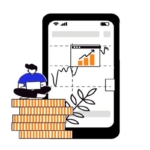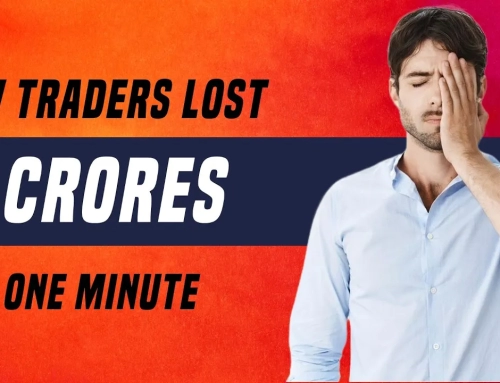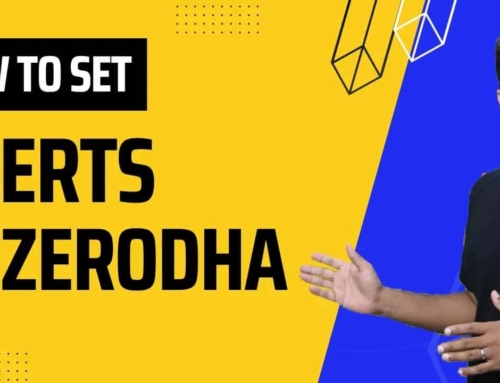Secret Weapon of Professional Traders
I want to start with a very interesting challenge which was given to me by a senior trader friend of mine.
So, this challenge was given to me by a professional trader when I was an amateur trader and this was more than a decade back. The challenge was very simple.
This trader challenged me that we will start with the same capital and I will follow everything that you do, so if you want to do swing trading, I will do swing trading. If you want to do intraday trading I will do intraday trading and I will trade the same stocks that you trade. So whatever stock selection that you will do I will follow the same stock.
Not only that, but I will also follow the same direction. If you want to take a long trade, and if you want me to take a short trade, I will take the short trade and on top of that, I will have the same time of entry as you and I will also have the same time of exit as you.
Lastly, to make sure that there was no ambiguity, he said whatever choice of instrument that you want to trade in such as futures, options or the cash segment, I am willing to trade in the same instrument. I felt like I was in complete control of this challenge.
This is because I’m the one who is deciding which stock to trade whether to go long or short, whether it’s an intraday or swing trade. Everything seemed to be in my control but what ended up happening just after a month of this challenge was the professional trader was much more profitable than I was at the end of the month.
Why the Difference?
So, the puzzle that I post for you guys is why the difference between the performance of the professional trader and the amateur trader? So, at the heart of this challenge, there was a secret weapon that the professional trader had which I was not aware of and because of that secret weapon, the professional trader ended up being more profitable than I did.
What is the Secret Weapon?
So, what is that secret weapon? Well, the secret weapon is Position Sizing.
Now some of you might be scratching your head that this doesn’t make a lot of sense because as I said, in the beginning, that both these traders started with the same capital. If they are starting with the same capital, how is it possible that the position size of one person is different from the other person?
Well, this is possible and not only it is possible, but it is also the secret weapon that professional traders deploy whenever they need it. The way I was taking the trades is that I had 10 lakh rupees of capital and in every trade, I was more or less taking trades worth 10 lakh rupees, but what the professional trader was doing is that he was varying his position sizes based on certain criteria.
What ended up happening is that trades where I was profitable, he was also profitable because he was following the same stock, same direction, same instrument, same time of entry and exit. However, in absolute terms, he was more profitable than I was because his position size in those trades was higher.
For example, let’s say I took a trade on Reliance with 10 lakh rupees of capital and I made let’s say 1% of profit and I made 10,000 rupees in that one trade, but he would take a 20 lakh or even 30 lakh rupees worth of trades. So, with the same entry, same exit and same choice of instrument, his absolute profit in that trade would be, let’s say 20,000 rupees or 30,000 rupees. Right.
That is how he was making sure that in the successful trades as he had a bigger position size.
What about the losing trades? Well, in the losing trade what I observed was that his position size was smaller than my position size. If I took a trade where I went wrong and I lost let’s say 1% on the trade, so on 10 lakh rupees say I lost 10,000 rupees he would have taken the same trade with a lower capital, a lower position size, let’s say five lakh rupees and so his absolute loss in that trade would have been 5,000 rupees.
So, guys, do you see the trend here by making sure that in the profitable trades, he had a bigger position size and in the losing trade he had a lower position size. This astute trader made sure that he was much more profitable than I was even though I was the one who was deciding almost every important aspect of the trade.
After the challenge was over when I realized what was going on, it made a lasting impact on my trading style and from that date till this date, I still use the technique that this trader taught me and I see the benefits on a day-to-day level.
I know that even though I can tell you that position sizing was a secret weapon that this professional trader used to win this challenge, but there are still some very important unanswered questions that might be going on in your mind.
So, question number one is how did that trader know that which trade was going to be profitable and which trades were going to be non-profitable? Secondly, what were the rules that he used to decide the position sizes?
So of course, position sizing is a very vast field and not everything can be covered in this one particular video.
So, what I will recommend to all of you is that the very interesting book called a Definitive Guide To Position Sizing by Van Tharp. He is a veteran trader in the US market and he has written this book which gives you a framework of how you should be thinking about risk, reward and how you should be sizing your position based on that. Now this book is a little bit technical and it’s also a little expensive so I can understand that all of you can’t buy this book and learn from this book.
But what we can do is that if you guys are serious about learning position sizing and the art of position sizing, give us feedback on this particular video. So give us likes, give us comments that you want to learn the tricks for sizing your position to make sure that you are making bigger profits and smaller losses.
I need to know that you are serious right. If you are serious then we will spend some more time and talk about this.
Three Rules for Position Sizing
As of now what I will do is I will share with you guys, three very important rules on position sizing.
First Rule
Rule number one is very simple. Position sizing is inversely proportional to the risk. So, if the risk in any particular trade is high your position size should automatically go down.
If I take the example of these trades, it doesn’t matter how much money I have in my account. The way I size my position is not based on the capital that I have but based on the risk that I am going to take.
It’s the trade that I took this morning so let’s say we take a 1200 quantity or 1800 quantity. I decide that purely based on the risk that I’m going to take in that particular trade and that is rule number one. As the risk goes higher, my position size has to go down so that if the risk materializes and I have to incur a loss, I will be incurring a loss on a smaller capital.
Now several factors impact the risk and the choice of instrument, for example, the risk of selling options is much higher than the risk of buying options or the risks can be based on the choice of stock that you picked.
So, Adani Enterprise for example probably will have a much higher risk than let’s say Reliance. The type of stock also can dictate the amount of risk that we are taking and there are at least 20 factors out there that determine the risk that I’m going to take in every trade and tracking these 20 factors is not always an easy job.
What I’ve done is we have automated some of these using Amibroker. We have built some logic and are still working on this right now to make sure that at least 70 to 80% of that analysis is already done by Amibroker and it gives us that recommendation and based on that we see the risk profile of this particular trade.
If the trade happens to be a very risky trade of course you know we will not even take the trade, but if the risk profile is medium, we will go with half the position size.
But if the risk profile is low, then we can even go full or even more than that. Depending on the risk profile of the trade, the choice of instrument, the type of stock and the time of entry and other factors, we decide whether we want to go with full position size, half position size or not trade at all.
Second Rule
Now my second rule, which again is a little subjective for me is that position size is directly proportional to the conviction.
So, what is conviction? How much conviction do I have in that particular trade? So, if I have a very high conviction, I will go with full position size, if I have a medium conviction then I will probably with half the position size or one-third of the position size and if I have a very low conviction of course I will not take the trade.
Today for example I took a long date on nifty, right in the morning. I took a long trade within five minutes of the market opening by shorting a put option. I took a long position on nifty, which of course made me some money and because I had a very high conviction on this particular trade, I almost went with my full position size not quite but almost. I probably would have added another 600 or maybe 1200 quantities, but then, the market had just opened and it was a little too soon for me to add the position.
So, I took a trade based on the conviction and the conviction in that state was high enough for me to warrant a decent position size. Now that is one little problem with conviction.
Conviction is subjective and whenever things become subjective, it becomes very hard for us to measure that and of course act on that. So conviction is something that also comes from experience.
What I did was I took a long trade this morning somewhere around here and I exited here based on my conviction. I took a trade here and somewhere around 10 o’clock, I exited the trade before the market came down.
So that time the conviction helped me and at 9:50, I exited this trade because, at that point of time, my conviction was low, that this market will give me any follow through at that point of time and so I exited but this conviction which helped me made 60,000 rupees also deceived me a little bit in the subsequent trade.
Hence, I took another long trade on bank nifty by shorting a put option at 173 rupees, which eventually came down to 92 rupees. I shorted it somewhere around here. It came down another a hundred points.
In this trade, I probably would have made at least 50,000 rupees, but I came out with hardly 2000 or 3000 rupees. So, conviction is not something that you can measure.
Even though I’m sharing with you that there is a high conviction or low conviction, you should be looking for ways to automate or make these rules that are a little bit more objective so that you’re not relying purely on your conviction.
As you can see that even I’m struggling with this aspect and I need to work a little bit more so that when the market gives me these kinds of opportunities like this today.
So, bank nifty, the way it moved today, I took a long trade somewhere around here and missed this rally. I took a long trade at a perfect time and there was no problem with this trade, but because the conviction was a little bit shaky at that point of time for several other reasons and hence I exited the trade.
Conviction, even though it sounds good but in reality, has both sides. It will help you to come out of bad trade and then of course will help you stay profitable. It sometimes can also prevent you from staying in profitable trade a little longer.
Try to look for more objective rules by which you can measure the level of conviction that you should be having in that particular trade.
Third Rule
Now, my last point here is that position size can be staggered during the entries and exits. What that means is that for example in this particular trade I took a trade with 1800 quantity I don’t need to enter or exit 1800 quantity at the same time. What I can do is I can start with the smaller quantity and if the trade starts to work in my favour then I can add more to the trade.
That is exactly what I did here. I took a trade with 1200 quantity but the market was moving very quickly. I had to add another 600 very quickly, but usually what I do is that I slowly add to the position as the level of conviction in the trade goes higher and higher and same as the trade with exit.
Here, my quantity was 1800 but I did not exit 1800 in one shot, so at 9:45 I exited with 600 quantities. I booked my profit at 9:50 that is five minutes after that, I booked another 600. After that I booked another 600 quantities and so by staggering your entries and exit in partial quantities, you can control the size of the position that you’re taking and you will have more time to decide whether the trade is worth sticking around or not.
So, guys, that is what the essence of position sizing is you need to size your positions based on risk, based on your conviction and there are many other factors that you have to keep in mind. So this is basic science, right? Sizing your position is a science.
You need to learn every aspect of how positions need to be sized and if you do that trust me even if you have an accuracy rate of let’s say 50% in your trades, you can still end up being profitable just using this secret weapon.
So, guys, as I said this is a very vast topic. If you guys want to learn more about this I will be more than happy to share that with you but I want to see how many of you are serious because I know that this is not that spicy kind of a topic that you know people have already mentioned interested into this is kind of a boring topic, but then trust me, money is made by these boring topics.
If you don’t mind getting bored, if you are serious about learning position sizing, let us know by liking this video so that we can continue educating our fellow traders.
Howdy!
If you’re here for the first time, let’s get introduced.
VRD Nation is India’s premier stock market training institute and we (Team VRD Nation) are passionate about teaching each and every aspect of investing and trading.
If you’re here for the first time, don’t forget to check out “Free Training” section where we have tons of free videos and articles to kick start your stock market journey.
Also, we got two awesome YouTube channels where you can continue the learning process.
Must-Read Articles
Secret Weapon of Professional Traders
I want to start with a very interesting challenge which was given to me by a senior trader friend of mine.
So, this challenge was given to me by a professional trader when I was an amateur trader and this was more than a decade back. The challenge was very simple.
This trader challenged me that we will start with the same capital and I will follow everything that you do, so if you want to do swing trading, I will do swing trading. If you want to do intraday trading I will do intraday trading and I will trade the same stocks that you trade. So whatever stock selection that you will do I will follow the same stock.
Not only that, but I will also follow the same direction. If you want to take a long trade, and if you want me to take a short trade, I will take the short trade and on top of that, I will have the same time of entry as you and I will also have the same time of exit as you.
Lastly, to make sure that there was no ambiguity, he said whatever choice of instrument that you want to trade in such as futures, options or the cash segment, I am willing to trade in the same instrument. I felt like I was in complete control of this challenge.
This is because I’m the one who is deciding which stock to trade whether to go long or short, whether it’s an intraday or swing trade. Everything seemed to be in my control but what ended up happening just after a month of this challenge was the professional trader was much more profitable than I was at the end of the month.
Why the Difference?
So, the puzzle that I post for you guys is why the difference between the performance of the professional trader and the amateur trader? So, at the heart of this challenge, there was a secret weapon that the professional trader had which I was not aware of and because of that secret weapon, the professional trader ended up being more profitable than I did.
What is the Secret Weapon?
So, what is that secret weapon? Well, the secret weapon is Position Sizing.
Now some of you might be scratching your head that this doesn’t make a lot of sense because as I said, in the beginning, that both these traders started with the same capital. If they are starting with the same capital, how is it possible that the position size of one person is different from the other person?
Well, this is possible and not only it is possible, but it is also the secret weapon that professional traders deploy whenever they need it. The way I was taking the trades is that I had 10 lakh rupees of capital and in every trade, I was more or less taking trades worth 10 lakh rupees, but what the professional trader was doing is that he was varying his position sizes based on certain criteria.
What ended up happening is that trades where I was profitable, he was also profitable because he was following the same stock, same direction, same instrument, same time of entry and exit. However, in absolute terms, he was more profitable than I was because his position size in those trades was higher.
For example, let’s say I took a trade on Reliance with 10 lakh rupees of capital and I made let’s say 1% of profit and I made 10,000 rupees in that one trade, but he would take a 20 lakh or even 30 lakh rupees worth of trades. So, with the same entry, same exit and same choice of instrument, his absolute profit in that trade would be, let’s say 20,000 rupees or 30,000 rupees. Right.
That is how he was making sure that in the successful trades as he had a bigger position size.
What about the losing trades? Well, in the losing trade what I observed was that his position size was smaller than my position size. If I took a trade where I went wrong and I lost let’s say 1% on the trade, so on 10 lakh rupees say I lost 10,000 rupees he would have taken the same trade with a lower capital, a lower position size, let’s say five lakh rupees and so his absolute loss in that trade would have been 5,000 rupees.
So, guys, do you see the trend here by making sure that in the profitable trades, he had a bigger position size and in the losing trade he had a lower position size. This astute trader made sure that he was much more profitable than I was even though I was the one who was deciding almost every important aspect of the trade.
After the challenge was over when I realized what was going on, it made a lasting impact on my trading style and from that date till this date, I still use the technique that this trader taught me and I see the benefits on a day-to-day level.
I know that even though I can tell you that position sizing was a secret weapon that this professional trader used to win this challenge, but there are still some very important unanswered questions that might be going on in your mind.
So, question number one is how did that trader know that which trade was going to be profitable and which trades were going to be non-profitable? Secondly, what were the rules that he used to decide the position sizes?
So of course, position sizing is a very vast field and not everything can be covered in this one particular video.
So, what I will recommend to all of you is that the very interesting book called a Definitive Guide To Position Sizing by Van Tharp. He is a veteran trader in the US market and he has written this book which gives you a framework of how you should be thinking about risk, reward and how you should be sizing your position based on that. Now this book is a little bit technical and it’s also a little expensive so I can understand that all of you can’t buy this book and learn from this book.
But what we can do is that if you guys are serious about learning position sizing and the art of position sizing, give us feedback on this particular video. So give us likes, give us comments that you want to learn the tricks for sizing your position to make sure that you are making bigger profits and smaller losses.
I need to know that you are serious right. If you are serious then we will spend some more time and talk about this.
Three Rules for Position Sizing
As of now what I will do is I will share with you guys, three very important rules on position sizing.
First Rule
Rule number one is very simple. Position sizing is inversely proportional to the risk. So, if the risk in any particular trade is high your position size should automatically go down.
If I take the example of these trades, it doesn’t matter how much money I have in my account. The way I size my position is not based on the capital that I have but based on the risk that I am going to take.
It’s the trade that I took this morning so let’s say we take a 1200 quantity or 1800 quantity. I decide that purely based on the risk that I’m going to take in that particular trade and that is rule number one. As the risk goes higher, my position size has to go down so that if the risk materializes and I have to incur a loss, I will be incurring a loss on a smaller capital.
Now several factors impact the risk and the choice of instrument, for example, the risk of selling options is much higher than the risk of buying options or the risks can be based on the choice of stock that you picked.
So, Adani Enterprise for example probably will have a much higher risk than let’s say Reliance. The type of stock also can dictate the amount of risk that we are taking and there are at least 20 factors out there that determine the risk that I’m going to take in every trade and tracking these 20 factors is not always an easy job.
What I’ve done is we have automated some of these using Amibroker. We have built some logic and are still working on this right now to make sure that at least 70 to 80% of that analysis is already done by Amibroker and it gives us that recommendation and based on that we see the risk profile of this particular trade.
If the trade happens to be a very risky trade of course you know we will not even take the trade, but if the risk profile is medium, we will go with half the position size.
But if the risk profile is low, then we can even go full or even more than that. Depending on the risk profile of the trade, the choice of instrument, the type of stock and the time of entry and other factors, we decide whether we want to go with full position size, half position size or not trade at all.
Second Rule
Now my second rule, which again is a little subjective for me is that position size is directly proportional to the conviction.
So, what is conviction? How much conviction do I have in that particular trade? So, if I have a very high conviction, I will go with full position size, if I have a medium conviction then I will probably with half the position size or one-third of the position size and if I have a very low conviction of course I will not take the trade.
Today for example I took a long date on nifty, right in the morning. I took a long trade within five minutes of the market opening by shorting a put option. I took a long position on nifty, which of course made me some money and because I had a very high conviction on this particular trade, I almost went with my full position size not quite but almost. I probably would have added another 600 or maybe 1200 quantities, but then, the market had just opened and it was a little too soon for me to add the position.
So, I took a trade based on the conviction and the conviction in that state was high enough for me to warrant a decent position size. Now that is one little problem with conviction.
Conviction is subjective and whenever things become subjective, it becomes very hard for us to measure that and of course act on that. So conviction is something that also comes from experience.
What I did was I took a long trade this morning somewhere around here and I exited here based on my conviction. I took a trade here and somewhere around 10 o’clock, I exited the trade before the market came down.
So that time the conviction helped me and at 9:50, I exited this trade because, at that point of time, my conviction was low, that this market will give me any follow through at that point of time and so I exited but this conviction which helped me made 60,000 rupees also deceived me a little bit in the subsequent trade.
Hence, I took another long trade on bank nifty by shorting a put option at 173 rupees, which eventually came down to 92 rupees. I shorted it somewhere around here. It came down another a hundred points.
In this trade, I probably would have made at least 50,000 rupees, but I came out with hardly 2000 or 3000 rupees. So, conviction is not something that you can measure.
Even though I’m sharing with you that there is a high conviction or low conviction, you should be looking for ways to automate or make these rules that are a little bit more objective so that you’re not relying purely on your conviction.
As you can see that even I’m struggling with this aspect and I need to work a little bit more so that when the market gives me these kinds of opportunities like this today.
So, bank nifty, the way it moved today, I took a long trade somewhere around here and missed this rally. I took a long trade at a perfect time and there was no problem with this trade, but because the conviction was a little bit shaky at that point of time for several other reasons and hence I exited the trade.
Conviction, even though it sounds good but in reality, has both sides. It will help you to come out of bad trade and then of course will help you stay profitable. It sometimes can also prevent you from staying in profitable trade a little longer.
Try to look for more objective rules by which you can measure the level of conviction that you should be having in that particular trade.
Third Rule
Now, my last point here is that position size can be staggered during the entries and exits. What that means is that for example in this particular trade I took a trade with 1800 quantity I don’t need to enter or exit 1800 quantity at the same time. What I can do is I can start with the smaller quantity and if the trade starts to work in my favour then I can add more to the trade.
That is exactly what I did here. I took a trade with 1200 quantity but the market was moving very quickly. I had to add another 600 very quickly, but usually what I do is that I slowly add to the position as the level of conviction in the trade goes higher and higher and same as the trade with exit.
Here, my quantity was 1800 but I did not exit 1800 in one shot, so at 9:45 I exited with 600 quantities. I booked my profit at 9:50 that is five minutes after that, I booked another 600. After that I booked another 600 quantities and so by staggering your entries and exit in partial quantities, you can control the size of the position that you’re taking and you will have more time to decide whether the trade is worth sticking around or not.
So, guys, that is what the essence of position sizing is you need to size your positions based on risk, based on your conviction and there are many other factors that you have to keep in mind. So this is basic science, right? Sizing your position is a science.
You need to learn every aspect of how positions need to be sized and if you do that trust me even if you have an accuracy rate of let’s say 50% in your trades, you can still end up being profitable just using this secret weapon.
So, guys, as I said this is a very vast topic. If you guys want to learn more about this I will be more than happy to share that with you but I want to see how many of you are serious because I know that this is not that spicy kind of a topic that you know people have already mentioned interested into this is kind of a boring topic, but then trust me, money is made by these boring topics.
If you don’t mind getting bored, if you are serious about learning position sizing, let us know by liking this video so that we can continue educating our fellow traders.















![What is Virtual Contract Note [Zerodha]](https://www.vrdnation.com/wp-content/uploads/2023/10/maxresdefault-virtual-note-500x383.jpg)



Leave A Comment